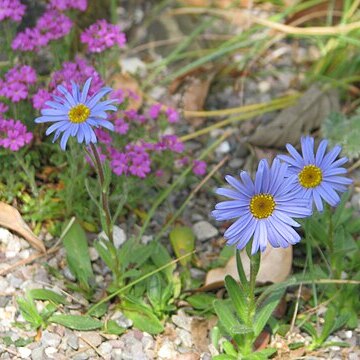Perennial herb, up to 300 mm high; rhizomatous. Stems unbranched, each with a single head. Leaves mostly in a basal rosette, alternate upwards; blade elliptic to obovate, margins entire or denticulate, 3-or 5-nerved, shortly and densely white-hairy; stem leaves smaller, narrowly obovate. Heads radiate, solitary, terminal on densely white-hairy and glandular stems. Involucral bracts 3-seriate, ± equal in size, long hairy and sparsely glandular. Flowers: ray florets blue; disc florets yellow; Sep.-Nov. Fruit with cypsela obovate, brown, shortly hairy. Pappus uniseriate, of barbellate bristles, of similar length.
Rhizomatous, perennial herb, up to 300 mm high. Leaves in a basal rosette, alternate upwards, elliptic to obovate, diminishing in size upwards, margins entire to denticulate, 1-5-nerved from base, densely hairy. Capitula radiate, solitary, terminal on hairy and glandular stems; involucral bracts arranged in 3 rows, equal in size, outer ones long-hairy and with some glands. Ray florets blue. Disc florets yellow. Flowering time Sept.-Dec. Pappus of barbellate bristles. Cypselae obovate, shortly hairy.
Perennial herb, up to 300 mm tall. Stems unbranched, each with a single head. Leaves in a basal rosette, elliptic to obovate, hairy. Involucral bracts equal, in 3 rows. Achenes shortly hairy. Flowers blue.

